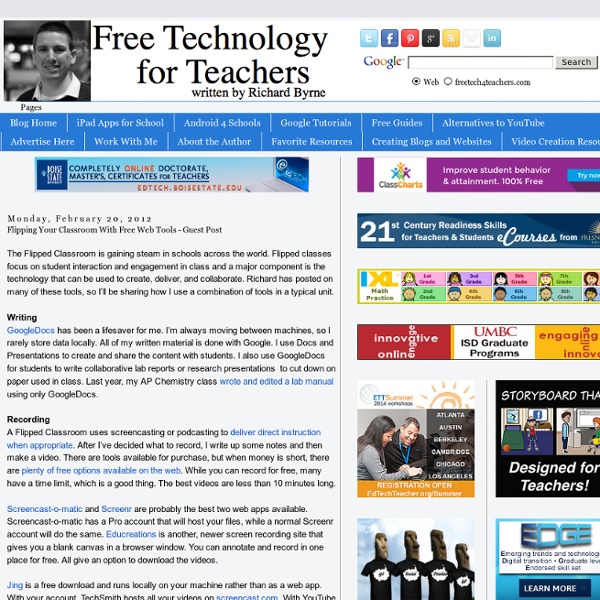



karimderrick: flipped in all subjects sh... cybraryman1: From @DaretoChem it's abou... Lesson Structure - Flipped Class Guide You've found your online resources, made your videos, and created some online games that will help your students learn the concepts you plan to demonstrate during your flipped lesson. What now? Determine the structure of your online flipped lesson. Below is a sample structure: 1. 2. 3. Video 2-5 minute clips that are teacher-created or existing resources (i.e. 4. Interactive GamesExamples with steps for solving themWays to use the skills in real life 5. QuizDetermine the minimum achievement level (75%? 6. Decide how you will follow up in class to reinforce the skills learned. 1. Presentation (brief!) 2. This eSchool News article called Flipped learning: A response to five common criticisms contains excellent responses to questions and reservations about the flipped concept. 21st Century Fluency Project - Flipped Learning: A Response to 5 Common Criticisms (posted on Ian Jukes' blog and based on the eSchool News article above)
Engage Students with Flipped Video Tasks The concept of the flipped classroom seems to be gaining ever increasing momentum within the field of education generally. Much of this revolves around the use of video to deliver input / lectures to students who can then come to class and do the more engaging and practical part of their work with some teacher support. One of the major criticisms of this method though is that a dull unengaging content doesn't suddenly become engaging because it's on a video on the web, so how do we get students to engage with the content and make sure they watch it in a challenging and interactive way. Vialogues is a useful tool for attempting to do this (though dull content will always be dull) because it enables you to create interaction around the video that actually gets students to think about and engage with the content. Here's an example Vialogue I created around one of my own (rather old) short videos. I hope you enjoy it.Related links: Best Nik Peachey
Can TED Talks Really Work in a Classroom? Teaching Strategies TED-Ed By Katrina Schwartz There’s been a lot of excitement around TED’s foray into education, bringing its inspirational video model to the classroom. But it’s a work in progress at the moment, until educators can figure out the best ways to use the videos. Under the math topic, for example, TED-Ed includes videos like How Folding Paper Can Get You to the Moon or Peter Donnelly Shows How Stats Fool Juries. “It’s by no means a comprehensive understanding. And it’s this curiosity that most teachers expect TED-Ed videos will feed. For example, Sams showed his class Just How Small is an Atom and incorporated the pre-made questions that accompanied it to give them a sense of awe about chemistry. TED-Ed videos aren’t meant to be a substitute for what happens in the classroom, said Logan Smalley, TED-Ed’s director. Stacey Roshan, a math teacher in Potomac, Maryland uses the videos in a similar way as Sams. But the real power of the new TED-Ed site is the platform itself.
There's More Than One Way to Flip a Classroom - Digital Education In a packed session this afternoon at ISTE 2012 here in San Diego, a panel of nine educators, as well as two moderators presented their ideas and experiences with "flipping" their classrooms. The session was led by Aaron Sams and Jonathan Bergmann, two chemistry teachers who pioneered the flipped learning model back in 2006. The pair recently co-wrote a book, published by ISTE and ASCD, called Flip Your Classroom. Defining what "flipping your classroom" meant was the first topic of conversation, which proved to be somewhat more difficult than you might expect. In fact, the reason the panel consisted of nine educators, instead of two or three, was precisely to demonstrate that there were many different ways to effectively flip a classroom. The flipped classroom has become somewhat synonymous with using videos to have students view lectures at home while in-class time is used for applied knowledge.
LyndsieGraves: Surve... How to “Flip this Lesson” Using YouTube and TED Ed When I wrote How "Flip This Lesson" by TED Ed Could Help Teachers More, on May 10, 2012, I got some push-back from tededlogan who wrote, "Hey there, Jumarqui. Thanks for doing this. I really enjoyed it, and it is helpful to hear and see a visitor interpreting the site out loud. However, I wanted to quickly point out that you didn’t click one of the more powerful features available on TED-Ed. The "flip this video" button. This allows you to customize the lesson and measure the learning results that your resulting lesson incurs. My response to this was that doing a simple walkthrough of the interface suited my purpose as an accompaniment for the blog post mentioned above as the post examined TED Ed as a classroom resource rather than as a content creation tool. Step 1: Create a Ted Ed account and log in at ed.ted.com Step 2: Locate the YouTube Video you are going to use as the basis for your lesson and copy the URL into your clipboard. That’s it.